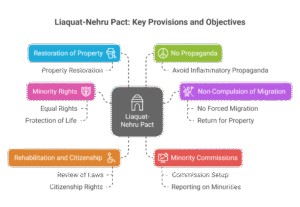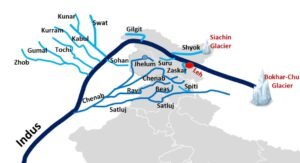India and Pakistan Relations: A Journey Through Conflict, Co-operation, and Complex Realities
- Related toIntl. Relation, Modern History
- Published on14 May 2025
 Isn’t it curious how two neighbours, born from the same historical and cultural roots, can grow into adversaries? India and Pakistan were once part of the same civilisation, shared languages, traditions, and even family ties. And yet, since their formation in 1947, the path of these two nations has been marked more by confrontation than cooperation.
Isn’t it curious how two neighbours, born from the same historical and cultural roots, can grow into adversaries? India and Pakistan were once part of the same civilisation, shared languages, traditions, and even family ties. And yet, since their formation in 1947, the path of these two nations has been marked more by confrontation than cooperation.
What happened after independence wasn’t just a political split; it was a rupture of identity, geography, and trust. The India-Pakistan relationship has seen everything from full-scale wars and covert operations to moments of diplomatic warmth and cultural kinship. To truly understand this complex story, we need to trace the arc from Partition to Pulwama, from the Indus Waters Treaty to Siachen, and from cricket diplomacy to surgical strikes. Read this Article about Indian Pakistan relations.
From Shared Roots to Divided Roads – Decoding the Story of Two Nations, One History, and a Strained ‘India and Pakistan Relations’
Partition and the Legacy of 1947
The division of British India into India and Pakistan in August 1947 wasn’t just a redrawing of boundaries; it was a human tragedy of epic proportions. Over a million people lost their lives, and nearly 15 million were uprooted from their homes, making it one of the largest mass migrations in human history. The Radcliffe Line, drawn hastily and with little knowledge of local complexities, split not only the land but also communities, families, and economic lifelines.
wasn’t just a redrawing of boundaries; it was a human tragedy of epic proportions. Over a million people lost their lives, and nearly 15 million were uprooted from their homes, making it one of the largest mass migrations in human history. The Radcliffe Line, drawn hastily and with little knowledge of local complexities, split not only the land but also communities, families, and economic lifelines.
Communal violence, refugee crises, and a deeply embedded sense of betrayal set the tone for India-Pakistan relations in the years to come. One of the earliest sparks was the question of Kashmir, where Pakistan-backed tribal militias invaded in 1947, leading to the first war between the two newly formed states. India took the matter to the United Nations, resulting in a ceasefire and the creation of a Line of Control — a line that still defines their military boundary.
The First Steps Toward Peace: Early Agreements
In the early years, despite tensions, efforts were made to establish peace and stability. The Liaquat-Nehru Pact of 1950 was a significant step, aiming to protect the rights of minorities in both countries. It ensured that refugees could return to their homes or choose to stay, and that their properties and civil liberties would be safeguarded.
While India chose a path of non-alignment during the Cold War, Pakistan aligned with Western military blocs like SEATO and CENTO. This difference in foreign policy further deepened the divide, especially as military aid to Pakistan altered the power dynamics in the region.
The Indus Waters Treaty: A Beacon of Cooperation
Amidst the backdrop of conflict, the Indus Waters Treaty (IWT) signed in 1960 stands as a rare and enduring symbol of cooperation. Brokered by the World Bank, the treaty divided the Indus basin’s rivers between the two nations — the eastern rivers (Beas, Ravi, Sutlej) to India and the western rivers (Indus, Chenab, Jhelum) to Pakistan. Despite wars and hostilities, the treaty has survived and functioned for over six decades.
But this cooperation hasn’t been without friction. India’s plans to build hydroelectric projects on the western rivers have faced objections from Pakistan, which fears a strategic manipulation of water flow. This has led to legal and diplomatic battles over projects like Kishenganga and Ratle.
The IndiaPakistan Wars That Shaped the Subcontinent
1965 War: A Clash Over Kashmir
The India Pakistan War in 1965 was initiated after Pakistan launched Operation Gibraltar, aiming to infiltrate Jammu and Kashmir and incite rebellion. India responded with full-scale military engagement. The war ended with the Tashkent Agreement, mediated by the Soviet Union, but the core issue of Kashmir remained unresolved.
1971 War: The Birth of Bangladesh
The third and most decisive war occurred in 1971, when India supported East Pakistan’s struggle for independence. The humanitarian crisis, with millions of refugees pouring into India, pushed India into a war that led to the creation of Bangladesh. The war concluded with over 90,000 Pakistani soldiers surrendering — one of the largest capitulations since World War II.
The Shimla Agreement (1972) that followed established the current Line of Control and emphasised bilateral resolution of disputes. However, peace remained elusive.
Kargil Conflict (1999)
Just when it seemed relations were improving — following Prime Minister Vajpayee’s historic visit to Lahore — Pakistani forces and militants occupied Indian posts in Kargil. Operation Vijay was launched to recapture the territory. The conflict ended in India’s favour, but it destroyed whatever goodwill the Lahore Declaration had built.
The Nuclear Chapter
In 1998, both nations conducted nuclear tests — India under Operation Shakti and Pakistan shortly after. These tests not only heightened tensions but also introduced a new element of deterrence.
Despite this, agreements like the Lahore Declaration and treaties on nuclear facility notifications were signed, showing that even adversaries could act responsibly on nuclear matters.
But as later events would show, the presence of nuclear weapons didn’t eliminate the threat of conflict; it merely changed its nature.
Terrorism: The Greatest Spoiler
The biggest obstacle in the peace process has been the persistent issue of cross-border terrorism. From the Parliament attack in 2001, to the 26/11 Mumbai attacks in 2008, and the more recent Pulwama attack in 2019, terrorist strikes originating from Pakistan-based groups have derailed every attempt at dialogue.
These attacks have not only claimed innocent lives but have also shifted public sentiment, hardened policies, and brought diplomatic efforts to a halt. The Indian response has varied from surgical strikes in 2016 to the Balakot airstrike in 2019, showing a new willingness to retaliate beyond the Loc.
The Siachen and Sir Creek Disputes
Siachen: The Frozen Conflict
Siachen, the world’s highest battlefield, became militarised in 1984 after India launched Operation Meghdoot to pre-empt a Pakistani takeover. The glacier remains contested due to an ambiguous demarcation in earlier ceasefire agreements.
India insists on jointly authenticating current military positions before discussing demilitarisation, fearing a repeat of the Kargil scenario if troops are withdrawn.
Sir Creek: The Salty Stretch of Dispute
The Sir Creek issue revolves around a 96-km estuary between Gujarat and Sindh. While it seems minor, the outcome impacts maritime boundaries and access to potential underwater resources. Fishermen often cross into each other’s waters, leading to arrests and humanitarian concerns.
China-Pakistan Economic Corridor (CPEC): A New Front
CPEC, part of China’s Belt and Road Initiative, passes through Gilgit-Baltistan, which India considers part of its sovereign territory. While Pakistan views it as an economic game-changer, India sees it as a violation of sovereignty and a sign of deepening China-Pakistan alignment. It has added another layer of geopolitical tension to the region.
The Kulbhushan Jadhav Saga
In 2016, Pakistan claimed to have arrested Indian national Kulbhushan Jadhav on charges of espionage. India maintained he was abducted from Iran. Denied consular access, India approached the International Court of Justice (ICJ). The court ordered Pakistan to provide consular access and review the sentence, but the issue remains unresolved.
This case became a symbol of mistrust and the fragility of bilateral mechanisms.
Trade: Lost Opportunities
At independence, India was Pakistan’s largest trading partner. Today, bilateral trade is negligible, often suspended due to political tensions. India withdrew Most Favoured Nation (MFN) status in 2019, and both countries raised tariffs or suspended trade altogether.
While trade could be a powerful tool for normalisation, political baggage continues to stifle economic cooperation.
Conclusion: Where Do We Go From Here?
The story of India and Pakistan is one of immense potential held back by political realities and historical wounds. For every handshake, there has been a backstab; for every treaty, a terror attack. Yet, the hope for peace persists — in shared culture, people-to-people ties, and diplomatic courage.
As Manmohan Singh once said, “I dream of a day when you can have breakfast in Amritsar, lunch in Lahore, and dinner in Kabul.” That dream remains distant but not impossible. The road to peace is hard, but the cost of hostility is harder.
If the subcontinent is to move forward, the two nations must choose dialogue over deadlock, empathy over enmity, and cooperation over confrontation.
-
Partition Tragedy (1947): The division led to over a million deaths and the displacement of nearly 15 million people, marking one of the largest mass migrations in history.
-
Kashmir Dispute: The princely state’s accession to India sparked the first Indo-Pak war in 1947–48, resulting in the establishment of the Line of Control (LoC).
-
Indus Waters Treaty (1960): Brokered by the World Bank, this treaty allocated the eastern rivers (Beas, Ravi, Sutlej) to India and the western rivers (Indus, Jhelum, Chenab) to Pakistan.
-
Suspension of Indus Waters Treaty (2025): Following the Pahalgam terror attack in April 2025, India suspended the treaty, citing national security concerns and alleging Pakistan’s support for cross-border terrorism. This move halted data sharing, commissioner meetings, and water flow notifications under the treaty.
-
Major Conflicts:
-
1965 War: Initiated over Kashmir, ending with the Tashkent Agreement.
-
1971 War: Led to the creation of Bangladesh and the surrender of over 90,000 Pakistani troops.
-
Kargil Conflict (1999): Pakistani forces occupied Indian posts in Kargil, leading to Operation Vijay.
-
-
Nuclear Tests (1998): Both nations conducted nuclear tests, introducing a new dimension to their rivalry.
-
Cross-Border Terrorism: Attacks like the 2001 Indian Parliament attack, 2008 Mumbai attacks, and 2019 Pulwama attack have severely strained relations.
-
Diplomatic Efforts: Initiatives like the Lahore Declaration (1999) and Agra Summit (2001) aimed at improving ties but were undermined by subsequent events.
-
Trade Relations: Bilateral trade has been minimal, often disrupted due to political tensions, with India revoking Pakistan’s Most Favoured Nation status in 2019.
-
People-to-People Ties: Despite political hostilities, cultural exchanges, shared heritage, and familial connections continue to foster informal bonds between citizens
Loved this article? Go to Learning EDGE+ Page↗️

